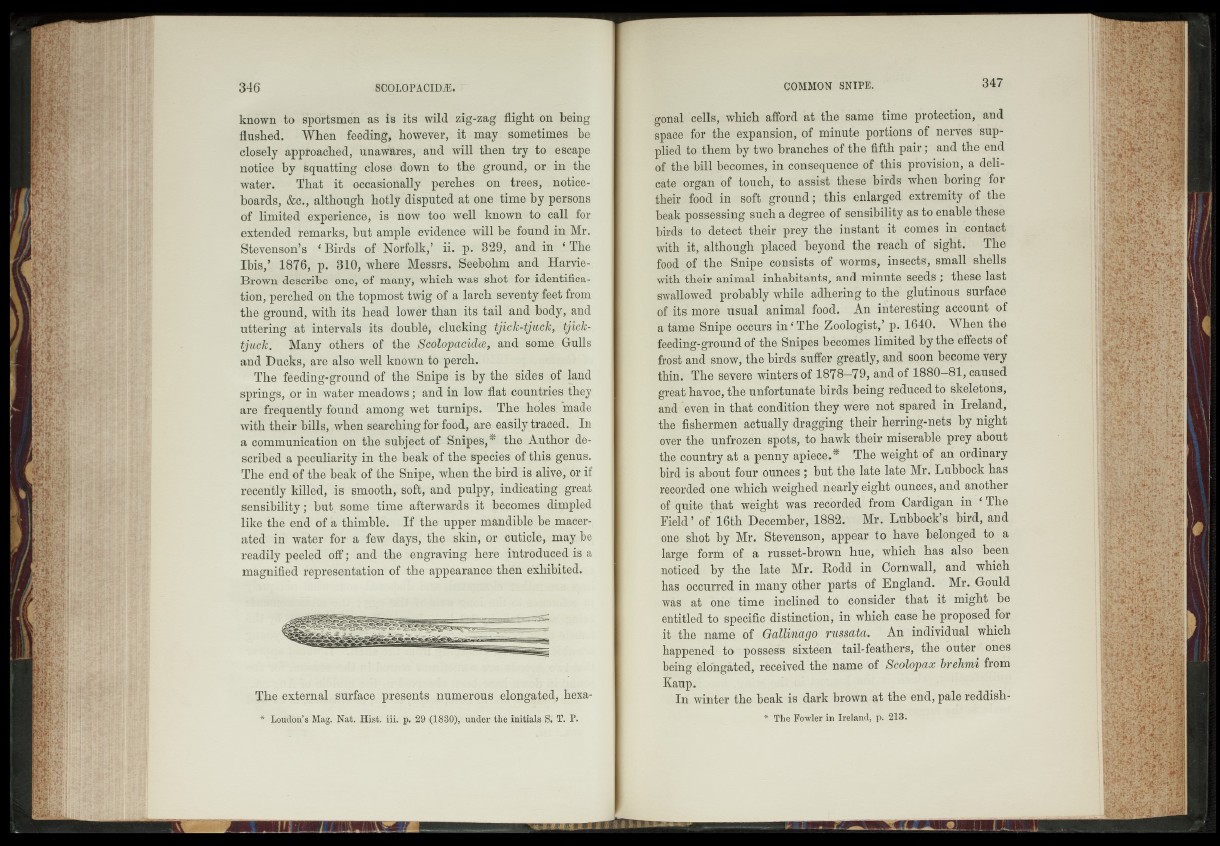
known to sportsmen as is its wild zig-zag flight on being
flushed. When feeding* however,: it may; sometimes be
closely approached, unawares, and will then try to escape
notice by Squatting close: down to the ground, or. in the
water. Tfhat it occasionally perchés on trees, -notice-
boards, &c., although hotly disputed at one time by persons
of limited experience* ïis now too well known-to- call for
extended remarks, but ample evidence will be/found in. Mr.
Stevenson’s ‘ Birds of Norfolk,’ ii. p. 829, and. in .‘ The
Ibis,’ 1876, p. 810, where Messrs. :Beebohm and .Harvie-
Brown describe one, of many* which was shot for identification,
perched on the topmost twig of a larch, seventy feet from
the ground, with its head lower than its tail and body, and
uttering at’Intervals its doublé, clucking. tjiâk-lgnçky^'fck-
tjuclc. Many others of the Sôolopacidoey.&nà some. Gulls
and Ducks, are also well known to perch.
The fêeding-ground of thé Snipe is by the sides .of land
springs, or in water meadows ; and in low flat countries they
are frequently found among wet turnips. The. hqlesi made
with their bills, when searching for food, are easily traced. In
a communication on the subject if- Snipes,* the Author described
a peculiarity in the beak of the Species of this genus.
The end of the beak of the .Snipe:, when the bird.is alive,' or if
recently killed, is smooth,' soft/and/pulpy, indicating'.great
sensibility ; but some’ time afterwards it becomes dimpled
like the end of a thimble. If -thecupper mandible be .macer-,
a-ted" in water for> a few days? the*-skin-, eh cuticle, may be,
readily peeled off ; and the '-engraving here introduced is a
magnified representation of the ' appearance thén exhibited.
The external surface presents numerous elongated, hexa-
* fpajféfejjl Mag; Nat. Hist. jBfeÿ. 29, (l§ 8£^,iÆder the initials Sr T. P.
•gonal cells, which afford at the same time protection, and
space for the expansion, of minute portions of nerves supplied
to them by two branches of the fifth pair; and the end
of the bill becomes, in consequènce of this provision, a delicate
organ of touch, to assist these birds when’boring 'for
their food in soft ( ground; this enlarged extremity of the
beak -possessing such a degree of sensibility as to enable these
birdsr to’ detect their prey the instant it comes in contact
with it, although placed beyond the reach of sight: J Thé
food bf~ the Snipe consists of worms, insects, small shells
with their animal inhabitants, and minute -seeds ; these last
swallowed ^probably while adhering to the' glutinous surface
of itsUmoré usual animal food/’ An interesting account of
a tame Snipe occurs in ‘The Zoologist,’ p. 1640. When the
feeding-ground of the Snipes becomes limited by the effects of
fr'o'stand snow/the birds'suffer greatly, and soon become wery
thin ./ The severe winters of 1878—79, and of 1880—81, caused
greathavoc, the unfortunate birds being reducbd to skeletons,
and "even in that condition they were not' sparbd in Ireland,
the fishermen' actually dragging théir herring-nets by night
over the unfrozen spots/ to hawk their miserable- prey about
the country at a penny apiece.* The weight?©f ah ordinary
bird is about four ounces ; but. the late late Mr. Lubbock has
recorded one.wh.ich weighed'^hèarly eight ounces, and another
ofe'quite. that wèight was- recorded- from Cardigan in ‘ The
Field ’ of 16th December, 1882/ Mr. Lubbock’s bird, and
one shot by Mr. StevensonpJ appear to have belonged to a
large' form ©fc A: russet-brown hue, ” which has also'been
noticed \ by/vthe laté Mr. Rodd ih-'?'Cornwall, and which
has * occurred in many other parts of England. Mr. Gould
was t at one vtime inclined to consider that it might be
entitled to specific distinction, in which case he proposed for
it/the name of GaUiridgo russata: iAh/individual which
happened Jo ~ possess sixtden tail-feathers, the outer ones
being elongated, rèceived the name of Scolopax "brelimi from
Kaup.
In winter the beak is dark brown at the end, pale reddish-
*' The Fowler in Ireland, p. 213'.